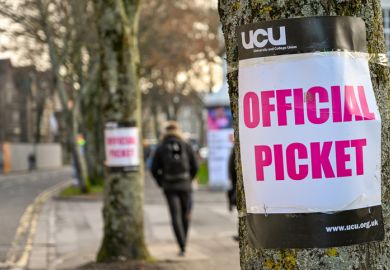Hundreds of UK academics risk losing their jobs if a “completely unexpected” increase in pension costs that will add almost £140 million to the wage bill of modern universities goes ahead, employers have warned.
In a briefing sent to institutions on 16 October, the Universities and Colleges Employers Association (Ucea) sets out the likely financial impact to the sector of “unprecedented” increases in employer contribution rates to the Teachers’ Pension Scheme (TPS), which runs pensions for about 43,000 staff in post-92 universities, announced by chief secretary to the Treasury Liz Truss last month.
Under the proposed changes due to take effect in September 2019, employers will be required to pay an extra 7.2 percentage points of salaries into the TPS, taking their overall contribution rate in England and Wales from 16.48 per cent to 23.68 per cent – a 44 per cent rise.
That is significantly higher than the 18 per cent of salary paid by the typically older institutions affiliated with the Universities Superannuation Scheme, which will increase to 19.5 per cent in April and 22.5 per cent in October 2019 under plans announced in July.
It is also higher than the 23.5 per cent of salary contributions suggested for USS employers by the University and College Union in January, which universities dismissed as “unaffordable”. Employee contributions for TPS members will remain unchanged.
Greg Walker, chief executive of MillionPlus, which represents modern universities, said the 44 per cent rise had “taken everybody by surprise” given the expectation of a 2 percentage point increase next year.
“If the proposed rise in employer contributions for USS threatened the health of older universities, this now applies equally for modern universities, if not more so,” Dr Walker said.
The increase follows what Ucea describes as a “completely unexpected” revaluation of the discount rate used to calculate the strength of public pension schemes, which has led to the sudden “substantial increases” in employer costs which will present an “exceptional challenge” to about 70 modern universities next year.
Ucea estimates that the new rate will add £130 million to the payroll costs of TPS-linked employers in England and Wales – the “equivalent of taking the fees paid by 14,000 undergraduate students in England and spending that fee income on pensions contributions”, it says.
The additional annual cost for eight universities in Scotland will be £8 million a year, it adds.
Universities will be hit far harder by the changes than schools and colleges, Ucea also says. While the Treasury has indicated that extra funds will made available to cover the increased costs, the Department for Education has “suggested support for schools would be prioritised” and it is “not clear” whether universities would receive any extra money at all, it says.
Universities will need to make substantial savings in staffing costs if the cost increase went ahead as planned, the briefing paper suggests.
One institution had informed Ucea that the cost increase would require a “necessary reduction in the region of 5 per cent of teaching workforce” while another said it would add £1.3 million to its cost base and it “may need to shed around 120 staff”.
Another said the “impact of staff numbers…will be inevitable and significant”, said Ucea in its briefing paper, which asked the Treasury to pause the valuation process to implement a full review and clarify whether institutions would receive extra money to cover additional costs.
Register to continue
Why register?
- Registration is free and only takes a moment
- Once registered, you can read 3 articles a month
- Sign up for our newsletter
Subscribe
Or subscribe for unlimited access to:
- Unlimited access to news, views, insights & reviews
- Digital editions
- Digital access to THE’s university and college rankings analysis
Already registered or a current subscriber?







